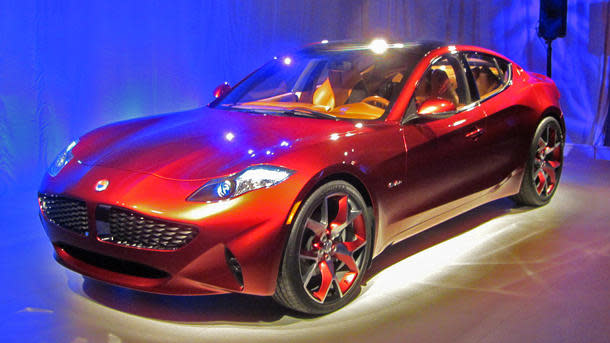 Motoramic
MotoramicFisker Atlantic reveal brings production pledge, but throws everything else up for grabs
At tonight's unveiling of the Fisker Atlantic, a smaller sequel to the Fisker Karma plug-in hybrid luxury sedan, the men who run Fisker pledged the car would go into production in the near future and that the company would have enough cash to survive. Everything else — from where the Atlantic will be built and its battery supplier to whether Fisker could partner with a larger automaker — has yet to be determined.
The presentation of the Atlantic was the first public event for Fisker's team since former Chrysler executive Tom LaSorda replaced founder and chief designer Henrik Fisker as chief executive. To the reporters gathered ahead of the New York Auto Show, Fisker, LaSorda and other executives stuck to their theme of plowing ahead, despite a myriad list of troubles from the Karma's launch and the failure to secure much of a $529 million loan from the U.S. Department of Energy.
LaSorda said his goal was to run Fisker assuming no Energy loan money would ever arrive — and that Fisker was self-sustaining with Karma production, as sales have hit 700 copies and generated $50 million in revenue in February. But LaSorda also said the business plan for the smaller Atlantic sedan remained a work in progress, with Fisker willing to consider a different battery supplier than A123 Systems — whose battery defect led to an embarrassing Karma lockup at Consumer Reports — and perhaps moving production from a former General Motors plant in Wilmington, Del.
"We're looking at other options, but the primary location is Wilmington," LaSorda said.
LaSorda also indicated Fisker would explore partnerships with other automakers, such as the deals Tesla has made with Toyota and Daimler which brought it much-needed cash while it tools its new factory for the Model S sedan.
To fill the shortfall of capital from the Energy department, Fisker raised a fresh round of $392 million from investors over the past few weeks, and LaSorda said the company would raise additional money through a high-yield debt issue. That cash will go toward developing not just the Atlantic but at least three variants.
As for the Atlantic itself, Fisker kept most details vague. Smaller but clearly similar to the Karma, Henrik Fisker said the Atlantic would compete with vehicles such as the Audi A5. Its power train will use a BMW 2-liter engine to recharge a battery pack — which has been redesigned to provide more trunk space and folding rear seats — but Fisker declined to give any other targets for the Atlantic's efficiency or performance.
Much as Tesla has done with the Model S, Fisker will take $5,000 deposits on the Atlantic — even though the company won't say exactly when the Atlantic will go into production beyond "sometime shortly after 2012." It's that kind of persistence — or bravado — that Henrik Fisker flashed when asked whether he had ever considered building a non-electric car rather than rising and falling with a complicated plug-in system.
"Never. We will rise, not fall," Fisker said.

 Yahoo Autos
Yahoo Autos 

